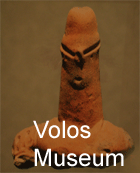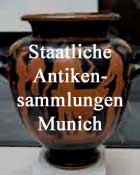|
|

Metropolitan Museum Vase Image Source tr002
Gisela A. Richter: The locality of the scene is indicated as the interior of a house by a fluted Ionic column on a plinth. To the right of this a woman, clothed in a short-sleeved chiton and mantle and wearing a fillet in her hair, is conversing with another woman, who is clothed in a long-sleeved chiton, mantle, and sakkos, and is seated in a chair with a kalathos beside her. The first woman holds a long fillet in her extended hands, as if offering it to the other, who holds up a flower in her right hand. The two women are evidently exchanging presents ; the one nearest the column we may suppose to have just entered the apartment (note that she does not wear the sakkos as do the other women in the scene), and to be bringing her friend a small present, while the hostess is offering a flower in return, as a mark of welcome. The woman on the right, who is hurrying away from this group, also holds a flower in her right hand, while her left is raised as if in surprise. She is probably hastening to the other women to tell them of the arrival of their friend or to leave the two by themselves. With her back to this group a woman in a long-sleeved chiton, mantle, and sakkos is seated in a chair, holding in both hands a string of beads of the shape that often occurs on Greek vases. In front of her stands a woman, similarly clothed, engaged in spinning. In the accustomed way she holds up in her left hand the distaff (elakate) with a hank of wool wound around it, to twist from it the thread between the thumb and first finger of her right hand. She is represented at the moment when she has drawn out a sufficient length of yarn, and is twisting it still more completely by twirling the spindle (atraktos), which she is holding over a kalathos filled with unworked wool. It is interesting to notice how clearly the several parts of the spindle are indicated. Above is the slit or catch (agkistron) with the thread securely fixed in it ; then comes the stick or spindle proper, and into the lower extremity of this is inserted a whorl (sfondylos), of which so many specimens have survived from antiquity. The scene is completed by the figure of another woman, clothed in a long-sleeved chiton and a sakkos, and seated in a chair. Her occupation is not so obvious as that of her companions. Her right leg is raised and supported upon a high foot-rest ; she bends slightly forward and her expression indicates that she is devoting her entire attention to her task. This seems to be the winding of the wool into a skein. The lump of spun wool is on the ground ; by passing the thread alternately between the second and third fingers, first of her right hand and then of her left, she is undoing the bobbin (penion) she had formed on the spindle, and winding the thread into a skein. Her dress is tucked up above her knee, leaving bare the lower part of her leg, over which she is drawing the thread to prevent it from snarling. Just such another representation does not, to my knowledge, occur on Greek vases or elsewhere. The several processes of actual spinning are common enough; but the treatment of the wool, when once it is spun, is not often shown, though we know that it was eventually wound into a ball (talyte, kloster), and balls of wool occur not infrequently in interior scenes.
 |
|||||||||||||||


